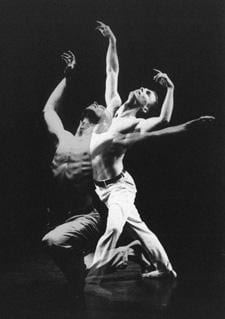February is upon us, and there’s nothing better to cheer the short, cold days than a gorgeous, tall, steaming hunk of a man — in tights, no less. Graham McKelvie is one of our country’s most enduring stars of modern dance, with a masculine athleticism that has inspired major roles in works by renowned choreographers like David Earle, James Kudelka and Patricia Beatty. But unlike many of his peers, a career in dance was the furthest thing from the Saskatchewan native’s mind when he first began to think about a life in the arts.
“The truth is that I got into dance because of a friend of mine,” says McKelvie. “I was in Grade 12 studying theatre and had won best actor for my year. My friend Sue was in the class with me and decided that we had to take some kind of movement class if we were going to be actors.”
Lessons with a Saskatoon ballet company lit a spark in the budding thespian, and when the National Ballet School came through town, holding auditions for students, McKelvie leapt at the chance. Despite his relatively late entrance into the field, McKelvie impressed the scouts enough to land both a position in the prestigious Toronto school and a full scholarship.
“It was kind of full-on Billy Elliot,” McKelvie says with a chuckle. “I got on that bus to Toronto with everything I owned and got to Toronto without knowing anyone there. It was quite a culture shock.”
Suddenly, the flamboyant teen whose New Wave style had shocked folks back home found himself in a metropolitan environment with the freedom to discover what he wanted to do and who he wanted to be.
“It’s funny when I look back on it,” says McKelvie. “Honestly, at the time I wasn’t even sexualized yet, so there hadn’t been the issue of coming out at home. So Toronto was a big discovery for me.”
As McKelvie became more comfortable with his sexuality, he began experimenting with the many styles of dance to which he was being exposed. And while he loved his ballet training, other disciplines began to spark his interest.
During summer school, McKelvie met modern-dance choreographer David Earle and realized where his future in the art form lay. “Right away, I loved it. David was just so full of impressions and images, all of which were so appealing to me. I went back to Toronto to study at the Toronto Dance Centre, and then I knew for sure.”
Now almost a quarter of a century into his career, McKelvie is still dancing roles that would prove demanding for someone half his age, as evidenced in his upcoming performance in Coleman Lemieux & Compagnie’s AllOneWord. It’s an evening of new work by James Kudelka, a choreographer known for pushing dancers to the limit of their abilities.
“James is very exacting,” says McKelvie. “He has a very astute eye and guides you firmly through the process, which generally is very demanding. He likes seeing the physical striving, to show that the piece is difficult enough that you have to try as hard as you can.”
While he clearly still possesses the physical excellence needed for these roles (not to mention an unbelievably rockin’ bod), McKelvie confesses to the inevitable changes that take place in a dancer’s body as it ages.
“It’s challenging,” he says. “I’ve lost some flexibility, but I can still do the splits in every direction. For a civilian, I’m in pretty good shape, and for a dancer, my body feels in many ways the same. But there’s always pain in dance, and for sure I have less tolerance for pain now. So consequently, you do work more mindfully as you get older.
“But I have to say, as you get older, dancing becomes more and more rewarding. The performance experience becomes richer, and you have a more intimate relationship with the music. I think that in getting older you realize the importance of things and of being alive. After all, dance is really just being alive with the volume turned up.”

 Why you can trust Xtra
Why you can trust Xtra


